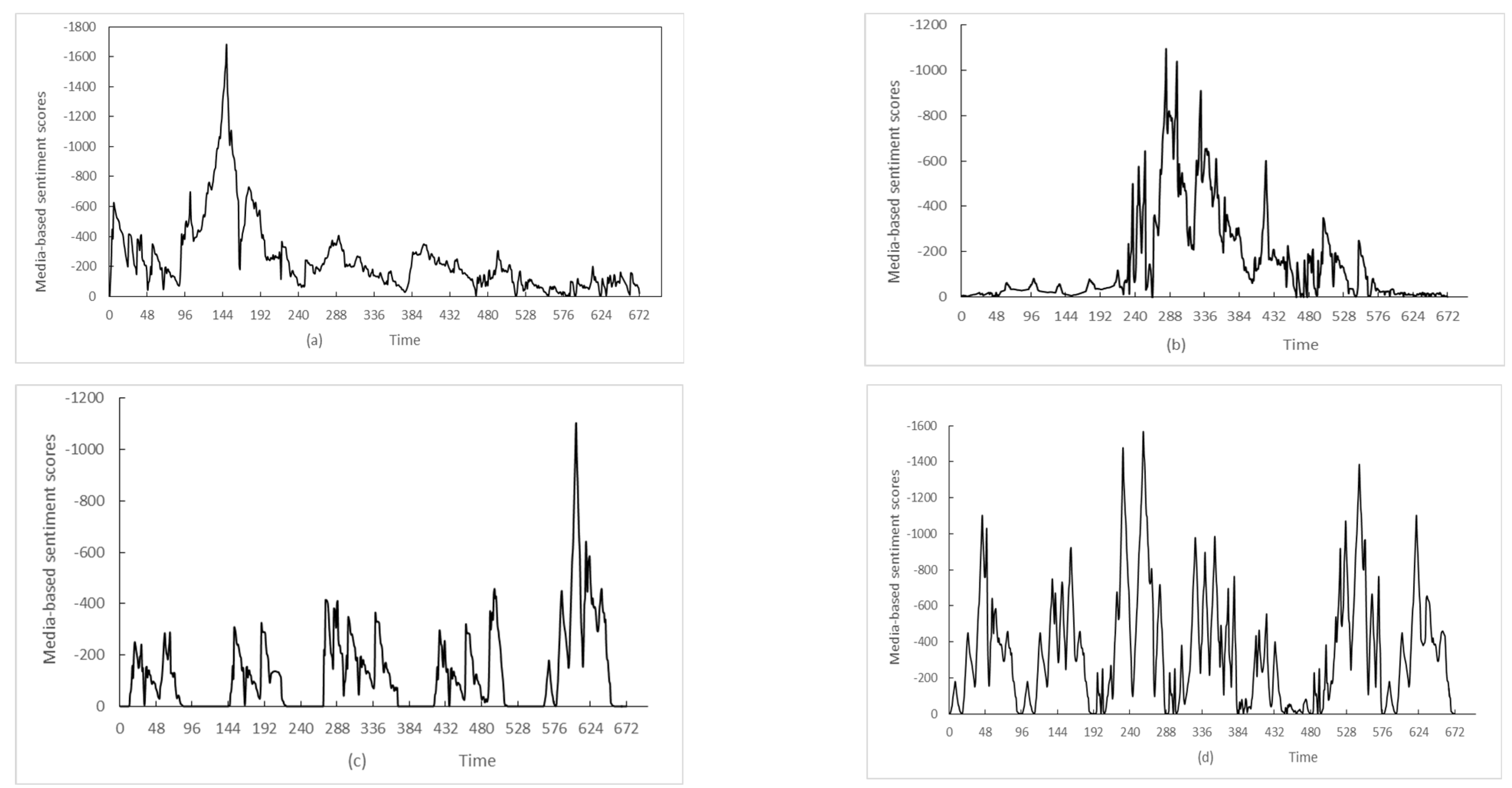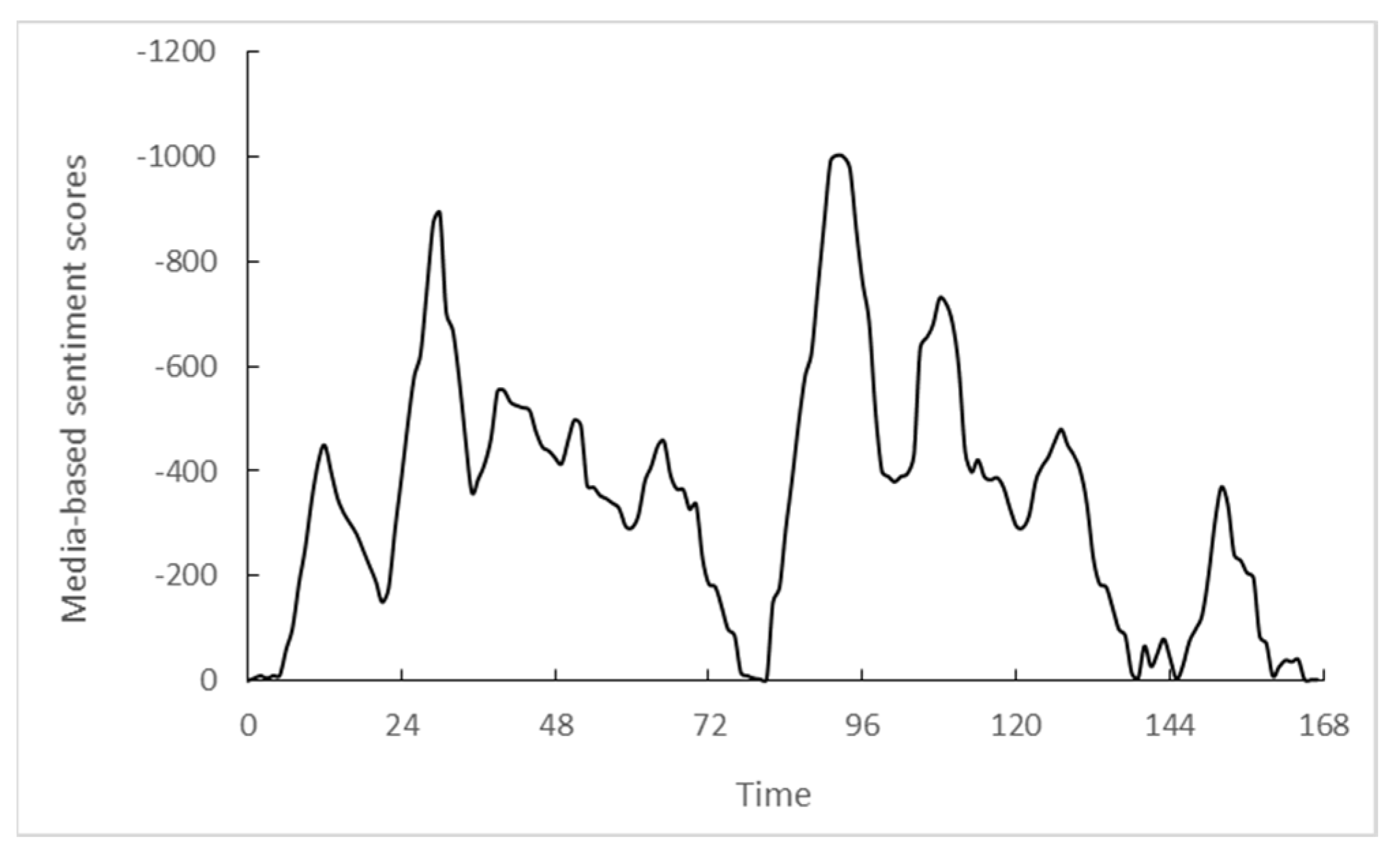A Dynamic Monitoring Method of Public Opinion Risk of Overseas Direct Investment—Based on Multifractal Situation Optimization
Abstract
:1. Introduction
2. Literature Review
3. Research Design
3.1. Construct the Multifractal–Based POR Situation Discriminative Model
3.1.1. Classify POR Events Using Mean-Shift Algorithms
3.1.2. Extract Multifractal Features of Each POR Class
3.1.3. Construct the POR Situation Discriminative Model
3.2. Construct a Fractal Interpolation-Based POR Prediction Model
3.2.1. Determine the Hurst Exponent
3.2.2. Construct the Fractal Interpolation-Based POR Situation Predict Model
4. Experimental Results
- (1)
- The historical POR evolutionary trends provide a certain reference for predicting the trend of the similar type of POR events, but it is difficult to achieve a high degree fitting of situation curve;
- (2)
- Using fractal feature data and real-time POR fractal interpolation method can both improve the prediction performance of the new POR situation to a certain extent. The former mainly by refining the subsequent classification results of the POR situation through mining the potential features of curves in different dimensions. The latter is mainly by improving the fit degree of the POR evolution by introducing real-time data interpolation. The prediction accuracy can be maintained with the extension of time and the increase in interpolation points;
- (3)
- Although there exists a bias between the prediction results based on the fractal interpolation algorithm in this paper with the actual measured value, the overall fitting evolutionary trend of POR is consistent with the reality, which proves that this method can improve the prediction accuracy of POR through the processing of the POR data captured.
5. Conclusions
Funding
Informed Consent Statement
Data Availability Statement
Acknowledgments
Conflicts of Interest
References
- Wang, G.; Chi, Y.; Liu, Y.; Wang, Y. Studies on a multidimensional public opinion network model and its topic detection algorithm. Inf. Process. Manag. 2019, 56, 584–608. [Google Scholar] [CrossRef]
- Gao, G.; Wang, T.; Zheng, X.; Chen, Y.; Xu, X. A Systems Dynamics Simulation Study of Network Public Opinion Evolution Mechanism. J. Glob. Inf. Manag. 2019, 27, 189–207. [Google Scholar] [CrossRef]
- Gong, C.; Du, Y.; Li, X.; Chen, X.; Li, X.; Wang, Y.; Zhou, Q. Structural hole-based approach to control public opinion in a social network. Eng. Appl. Artif. Intell. 2020, 93, 103690. [Google Scholar] [CrossRef]
- Zhang, J.; Wang, X.; Xie, Y.; Wang, M. Research on multi-topic network public opinion propagation model with time delay in emergencies. Phys. A Stat. Mech. Its Appl. 2022, 600, 127409. [Google Scholar] [CrossRef]
- Karamouzas, D.; Mademlis, I.; Pitas, I. Public opinion monitoring through collective semantic analysis of tweets. Soc. Netw. Anal. Min. 2022, 12, 91. [Google Scholar] [CrossRef] [PubMed]
- Zhu, Y. Network Public Opinion Prediction and Control Based on Edge Computing and Artificial Intelligence New Paradigm. Wirel. Commun. Mob. Comput. 2021, 2021, 5566647. [Google Scholar] [CrossRef]
- Li, M.; Li, A. A Network Public Opinion Trend Estimation Model Using a Scale-Free Network Algorithm. Mob. Inf. Syst. 2022, 2022, 6784694. [Google Scholar] [CrossRef]
- Meng, F.; Xiao, X.; Wang, J. Rating the Crisis of Online Public Opinion Using a Multi-Level Index System. Int. Arab J. Inf. Technol. 2022, 19. [Google Scholar] [CrossRef]
- Peng, L.; Shao, X.; Huang, W. Research on the Early-Warning Model of Network Public Opinion of Major Emergencies. IEEE Access 2021, 9, 44162–44172. [Google Scholar] [CrossRef] [PubMed]
- Li, J.; Zhang, N.; Center, N. Analysis on coping strategies of network public opinion in new media era. China Med. Her. 2019, 16, 185. [Google Scholar]
- Bonifazi, G.; Cauteruccio, F.; Corradini, E.; Marchetti, M.; Sciarretta, L.; Ursino, D.; Virgili, L. A Space-Time Framework for Sentiment Scope Analysis in Social Media. Big Data Cogn. Comput. 2022, 6, 130. [Google Scholar] [CrossRef]
- Yin, H.; Yang, S.; Li, J. Detecting topic and sentiment dynamics due to COVID-19 pandemic using social media. In Lecture Notes in Computer Science, Proceedings of the International Conference on Advanced Data Mining and Applications, ADMA’20, Foshan, China, 12–15 December 2020; Springer: Foshan, China, 2020; pp. 610–623. [Google Scholar]
- Xu, Y.; Li, Y.; Liang, Y.; Cai, L. Topic-sentiment evolution over time: A manifold learning-based model for online news. J. Intell. Inf. Syst. 2020, 55, 27–49. [Google Scholar] [CrossRef]
- Pröllochs, N.; Bär, D.; Feuerriegel, S. Emotions explain differences in the diffusion of true vs. false social media rumors. Sci. Rep. 2021, 11, 22721. [Google Scholar] [CrossRef] [PubMed]
- Gallacher, J.; Bright, J. Hate Contagion: Measuring the spread and trajectory of hate on social media. PsyArXiv 2021. Preprint. [Google Scholar] [CrossRef]
- Bonifazi, G.; Cauteruccio, F.; Corradini, E.; Marchetti, M.; Terracina, G.; Ursino, D.; Virgili, L. A framework for investigating the dynamics of user and community sentiments in a social platform. Data Knowl. Eng. 2023, 146, 102183. [Google Scholar] [CrossRef]
- Guan, Y.-M.; Wang, G.; Zou, B.; Lv, L.; Shi, Y.-L. Network public opinion monitoring method based on multi-divisional optimization. Comput. Integr. Manuf. Syst. 2022, 28, 1258–1266. [Google Scholar]
- Suykens, J.A.K. Support Vector Machines: A Nonlinear Modelling and Control Perspective. Eur. J. Control 2001, 7, 311–327. [Google Scholar] [CrossRef]
- Zhai, M.Y. A new method for short-term load forecasting based on fractal interpretation and wavelet analysis. Int. J. Electr. Power Energy Syst. 2015, 69, 241–245. [Google Scholar] [CrossRef]
- Goutte, C.; Gaussier, E. A Probabilistic Interpretation of Precision, Recall and F-Score, with Implication for Evaluation. In Proceedings of the 27th European Conference on Advances in Information Retrieval Research, Santiago de Compostela, Spain, 21–23 March 2005. [Google Scholar] [CrossRef]
- Hochreiter, S.; Schmidhuber, J. Long short-term memory. Neural Comput. 1997, 9, 1735–1780. [Google Scholar] [CrossRef] [PubMed]



| Dataset Processing Strategy | Accuracy of Classification | Forecast Period One Week | Forecast Period Two Weeks | Forecast Period Three Weeks | |||
|---|---|---|---|---|---|---|---|
| Forecast Accuracy (%) | F1 Score (%) | Forecast Accuracy (%) | F1 Score (%) | Forecast Accuracy (%) | F1 Score (%) | ||
| Non-fractal feature data + no real-time POR data interpolation | 83.62 | 72.56 | 70.34 | 71.22 | 70.65 | 69.21 | 68.35 |
| Fractal feature data + no real-time POR data interpolation | 95.88 | 81.27 | 75.89 | 76.23 | 74.12 | 71.37 | 73.28 |
| Non-fractal feature data + real-time POR data interpolation | 82.36 | 82.67 | 82.78 | 84.71 | 83.37 | 84.26 | 82.67 |
| Fractal feature data + real-time POR data interpolation | 95.88 | 93.62 | 92.56 | 91.57 | 93.25 | 91.44 | 93.27 |
| Method | Forecast Accuracy (%) | F1 Value (%) |
|---|---|---|
| LSTM | 80.01 | 76.35 |
| Multifractal situation optimization | 95.17 | 96.23 |
Disclaimer/Publisher’s Note: The statements, opinions and data contained in all publications are solely those of the individual author(s) and contributor(s) and not of MDPI and/or the editor(s). MDPI and/or the editor(s) disclaim responsibility for any injury to people or property resulting from any ideas, methods, instructions or products referred to in the content. |
© 2023 by the author. Licensee MDPI, Basel, Switzerland. This article is an open access article distributed under the terms and conditions of the Creative Commons Attribution (CC BY) license (https://creativecommons.org/licenses/by/4.0/).
Share and Cite
Li, Y. A Dynamic Monitoring Method of Public Opinion Risk of Overseas Direct Investment—Based on Multifractal Situation Optimization. Entropy 2023, 25, 1491. https://doi.org/10.3390/e25111491
Li Y. A Dynamic Monitoring Method of Public Opinion Risk of Overseas Direct Investment—Based on Multifractal Situation Optimization. Entropy. 2023; 25(11):1491. https://doi.org/10.3390/e25111491
Chicago/Turabian StyleLi, Yong. 2023. "A Dynamic Monitoring Method of Public Opinion Risk of Overseas Direct Investment—Based on Multifractal Situation Optimization" Entropy 25, no. 11: 1491. https://doi.org/10.3390/e25111491
APA StyleLi, Y. (2023). A Dynamic Monitoring Method of Public Opinion Risk of Overseas Direct Investment—Based on Multifractal Situation Optimization. Entropy, 25(11), 1491. https://doi.org/10.3390/e25111491






